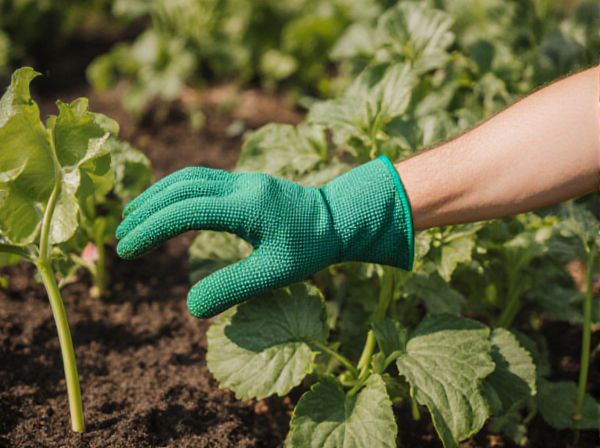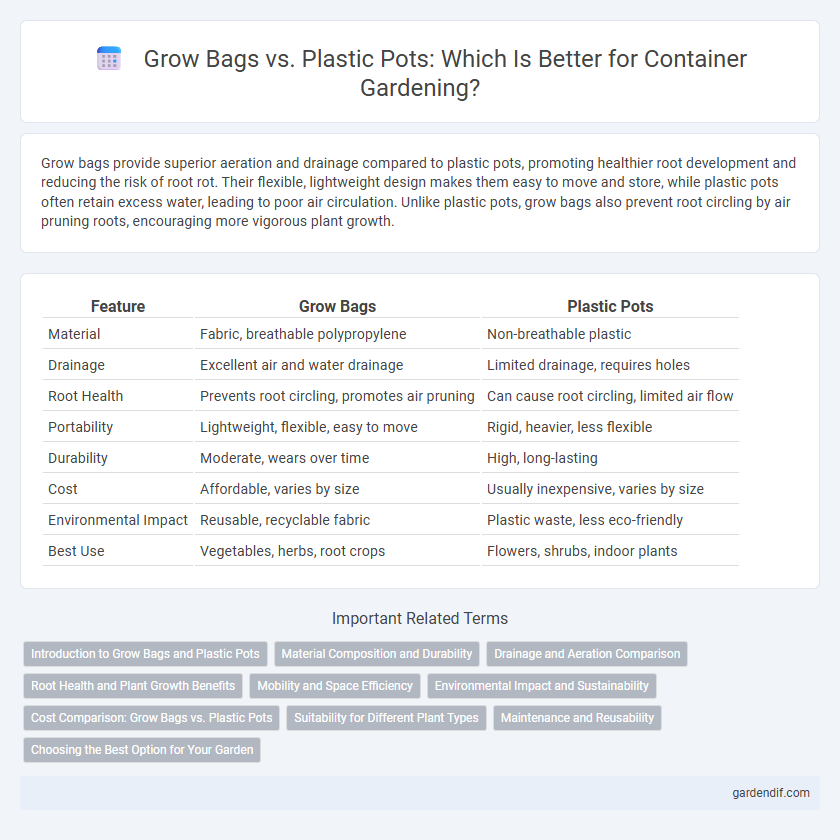
Grow bags vs plastic pots Illustration
Grow bags provide superior aeration and drainage compared to plastic pots, promoting healthier root development and reducing the risk of root rot. Their flexible, lightweight design makes them easy to move and store, while plastic pots often retain excess water, leading to poor air circulation. Unlike plastic pots, grow bags also prevent root circling by air pruning roots, encouraging more vigorous plant growth.
Table of Comparison
| Feature | Grow Bags | Plastic Pots |
|---|---|---|
| Material | Fabric, breathable polypropylene | Non-breathable plastic |
| Drainage | Excellent air and water drainage | Limited drainage, requires holes |
| Root Health | Prevents root circling, promotes air pruning | Can cause root circling, limited air flow |
| Portability | Lightweight, flexible, easy to move | Rigid, heavier, less flexible |
| Durability | Moderate, wears over time | High, long-lasting |
| Cost | Affordable, varies by size | Usually inexpensive, varies by size |
| Environmental Impact | Reusable, recyclable fabric | Plastic waste, less eco-friendly |
| Best Use | Vegetables, herbs, root crops | Flowers, shrubs, indoor plants |
Introduction to Grow Bags and Plastic Pots
Grow bags are lightweight, breathable containers made from fabric that promote air pruning of roots, enhancing plant health and growth. Plastic pots, constructed from durable, non-porous materials, offer excellent water retention and are widely used for their reusability and ease of handling. Both grow bags and plastic pots come in various sizes and shapes, making them suitable for diverse container gardening needs.
Material Composition and Durability
Grow bags are typically made from breathable fabrics such as polypropylene or felt, allowing for better air circulation and root aeration compared to traditional plastic pots made from rigid polyethylene or PVC materials. The porous nature of grow bags promotes healthier root systems by preventing root circling and ensuring consistent moisture retention, while plastic pots offer more structural durability and resistance to external damage. Over time, grow bags may degrade under prolonged UV exposure and require replacement, whereas plastic pots generally maintain their integrity longer but can contribute to environmental waste if not recycled properly.
Drainage and Aeration Comparison
Grow bags provide superior drainage and aeration compared to plastic pots due to their breathable fabric material, which allows excess water to escape and air to circulate freely around the roots. Plastic pots often retain water and limit airflow, increasing the risk of root rot and compacted soil. Enhanced root oxygenation in grow bags promotes healthier, more vigorous plant growth and prevents waterlogged conditions.
Root Health and Plant Growth Benefits
Grow bags promote superior root health by allowing air pruning, which prevents root circling and encourages a dense, fibrous root system, enhancing nutrient absorption. Plastic pots often restrict root expansion and create anaerobic conditions, leading to weaker roots and potential root rot. Improved aeration and drainage in grow bags support robust plant growth and higher yields compared to traditional plastic containers.
Mobility and Space Efficiency
Grow bags provide superior mobility due to their lightweight and flexible design, allowing easy relocation and storage compared to rigid plastic pots. Their collapsible nature maximizes space efficiency in small growing areas or during seasonal changes. Plastic pots, while durable, often occupy more fixed space and are bulkier to move, limiting flexibility in container gardening setups.
Environmental Impact and Sustainability
Grow bags offer superior environmental benefits compared to plastic pots by being made from breathable, often biodegradable materials that reduce plastic waste pollution. Plastic pots contribute significantly to landfill accumulation due to their non-biodegradable nature and low recycling rates. Selecting grow bags supports sustainable gardening practices by minimizing long-term environmental footprints and promoting healthier root development.
Cost Comparison: Grow Bags vs. Plastic Pots
Grow bags generally cost less than plastic pots due to lower manufacturing and material expenses, making them a budget-friendly choice for gardeners. While plastic pots offer durability and reusability, their initial price and potential replacement costs can be higher over time. Considering long-term investment, grow bags often provide better value for seasonal planting projects and large-scale container gardening.
Suitability for Different Plant Types
Grow bags provide superior aeration and drainage, making them ideal for root vegetables, herbs, and delicate plants that require well-ventilated soil. Plastic pots, with their sturdier structure and retained moisture, are better suited for larger ornamental plants, succulents, and water-dependent species. Both containers support diverse plant types, but selecting the appropriate option depends on specific root growth patterns and moisture requirements.
Maintenance and Reusability
Grow bags require less maintenance due to their breathable fabric, which prevents root rot and improves aeration, reducing the need for frequent watering compared to plastic pots. Plastic pots are durable and reusable for multiple planting cycles but can retain moisture, increasing maintenance to prevent overwatering and mold growth. Grow bags offer eco-friendly reusability with biodegradable options, while plastic pots are more prone to wear and may eventually crack or degrade under UV exposure.
Choosing the Best Option for Your Garden
Grow bags offer superior aeration and drainage compared to plastic pots, which helps prevent root rot and promotes healthier root development. Plastic pots retain moisture longer, making them suitable for plants that require consistent hydration but may lead to waterlogging if not monitored. Selecting between grow bags and plastic pots depends on your garden's plant types, watering habits, and the need for portability or durability.
Grow bags vs plastic pots Infographic

 gardendif.com
gardendif.com